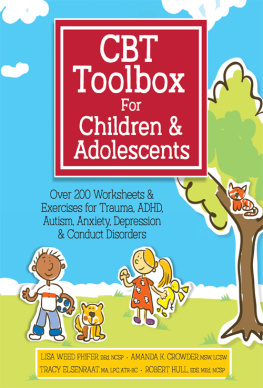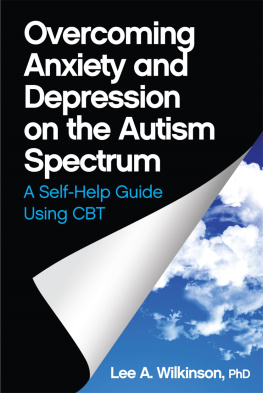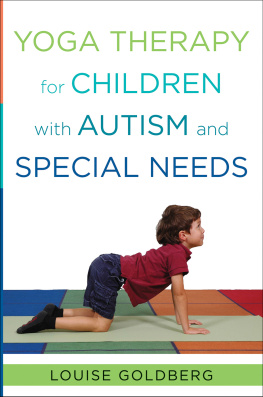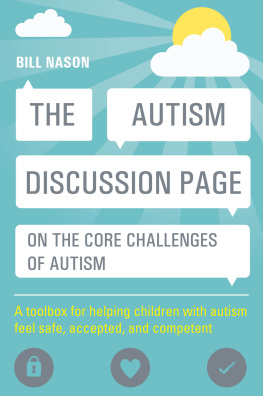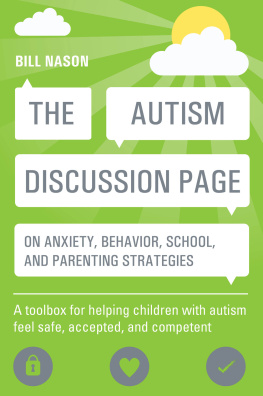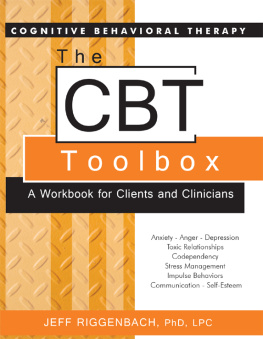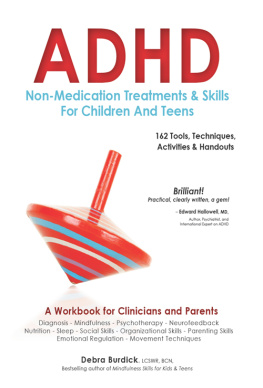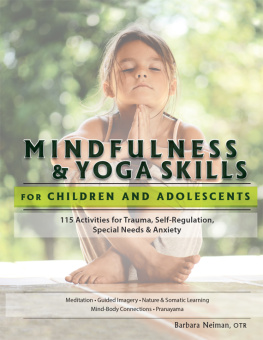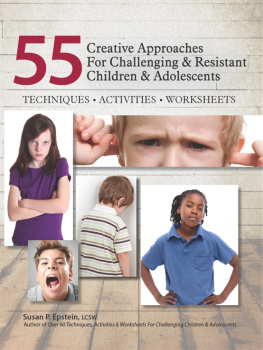CBT
Toolbox
For
Children & Adolescents
Over 200 Worksheets & Exercises for Trauma, ADHD, Autism, Anxiety, Depression & Conduct Disorders
LISA WEED PHIFER, DEd, NCSP
AMANDA K. CROWDER, MSW, LCSW
TRACY ELSENRAAT, MA, LPC, ATR-BC
ROBERT HULL, EDS, Med, NCSP
CBT Toolbox for Children and Adolescents copyright 2017 by Lisa Phifer, Amanda K. Crowder, Tracy Elsenraat, Robert Hull.
Published by:
PESI Publishing & Media
PESI, Inc.
3839 White Ave.
Eau Claire, WI 54703
Cover Design: Amy Rubenzer
Editing By: Blair Davis
Layout: Amy Rubenzer & Mayfly Designs
Printed in the United States of America
ISBN: 9781683730750
All rights reserved.
Acknowledgments
I n 2015, Hillary Jenness of PESI asked us to consider creating a book that would support therapists working with children who have emotional and behavioral disorders. We welcomed this opportunity and got right to work on creating this very practical book on activity-based cognitive behavioral therapy. We collaborated with colleagues of varying disciplines to create a workbook with engaging activities for clients, therapists, and caregivers. We want to express our sincere thanks and gratitude first to Hillary and PESI for this opportunity and also Sarah Porzig and Elissa Kauffman.
We would also like to acknowledge the many therapists and support people who dedicate their time, lives, and hearts to transforming the lives of children.
LISA WEED PHIFER, DEd, NCSP
AMANDA K. CROWDER, MSW, LCSW
TRACY ELSENRAAT, MA, LPC, ATR-BC
ROBERT HULL, EDS, Med, NCSP
Introduction
C BT Toolbox for Children and Adolescents was designed with therapists in mind to provide brief, targeted solutions to a myriad of mental health issues that are frequently present in children. The activities in this workbook enhance traditional CBT by promoting the development of a childs executive functioning, developing social skills, and prompting whole brain approach. Traditional therapy relies heavily on language and the activities in this book accompany language with nonverbal activities to help facilitate growth with individuals who have difficulties reflecting and changing their own negative thinking. This book used a multidisciplinary approach relying on the expertise of school psychologists, social workers and therapists. We have put together an abundance of creative ideas that can engage and inspire allowing clients to express themselves, communicate with others and create positive change.
The workbook covers six clinical areas: Childhood Trauma, Attention Deficit Hyperactivity Disorder, Autism Spectrum Disorder, Conduct Disorder, Anxiety, and Depression. The activities are tailored to specific disorders and symptomology and can be combined to meet the clients needs in regards to interrupting negative thought patterns, developing healthy relationships, and creating a mind-body connection. Within each chapter are four content areas tailored to the specific disorder.
1. Cognitive Skills
These activities focus on recognizing symptoms, determining the impact of negative thinking patterns, and enhancing memory strategies.
2. Relationship Coaching
These activities focus on the development of pro-social behavior, building alliances, and improving interpersonal relationships.
3. Competency Building
These activities target emotional regulation, realistic thinking, coping, and problem solving.
4. Brain-Based Learning
These activities focus on developing a mind-body connection, finding motivation, and developing healthy mental and physical habits.
How to Use this Book
This workbook provides activities to address countless symptoms with skill-building exercises. You will notice three types of worksheets: In-session Exercise, Client Activity and Caregiver Worksheet. These handouts have different uses and each one is written from a different perspective.
In-session Exercises are designed for the therapist to use as a tool while in-session. Including the client, caregiver and therapist in one setting, they are made to spark conversation and make the client comfortable.
Client Activities are created for the child to do themselves either in-session or as homework. Whether supervised by the therapist or their caregiver, they will be able to do the activity at any age or stage in the treatment process.
Caregiver Worksheets are for the parent or caregiver-to help them cope and work with the therapist, and also allow them to become part of the therapy process and reinforce strategies being taught in-session.
Although suggestions, ideas, and specific instructions are given, we encourage creativity within your own setting and specialty. These activities can be used to engage children directly in therapy, used in a group format for at-risk children, or as a strength building competency activity. As every therapist knows, skills that are repetitively practiced outside of therapy have a greater chance of being retained and used when faced with challenges.
Think Outside the PAGE
Let these activities act as a springboard to your own creativity. All these activities can be adapted to meet your clients age, developmental capacity, or current stage in treatment. It is important to let the client dictate when a piece is completed and how much they would like to expand the given directive. If a client is invested in a certain activity, you may consider letting him or her work on it over several sessions to maximize your information gathering. A loosely structured approach allows more opportunities for your client to encounter challenges in the process, which will result in opportunities for problem solving, skill building, and relationship building. Keep in mind that once an activity is completed, the clients processing of those skills continues.
Go Beyond the Activity Itself!
The activity or art piece is significantly important to the therapeutic process, the dialogue about the activity is equally important. Consider having the client title each activity and journal about it. Engage in discussions with the client regarding his or her feelings about this process of creating by using nonjudgmental commentary and open-ended questioning.
The artwork is an extension of self to be honored; therefore, it is important to have a plan for what to do with completed pieces to honor them and protect them. This ritual offers closure to the creative process. Options to consider include creating a portfolio to keep in the office until treatment is ended or for the client to take home. You may also find a safe place for the artwork to be on display in the office or use the artwork in other treatment activities; for example, many of the pieces created in session would double nicely as a focal point for guided imagery activities. The artwork could also be used in the clients home as a daily reminder of skills to practice or as a banner of pride and accomplishment. Process these options with the client ahead of time and come to an agreed plan.
Keep in mind that once an activity is completed, the clients processing of those skills continues. There are therapeutic advantages to repeating activities at different points in the therapeutic process. You might consider having the client do the activity again in the same way it was done before and then process the differences. Another option would be to complete a similar version of the activity to better meet where the client is at that particular point in treatment. Both options offer the client opportunity for repetition and mastery.
Next page
